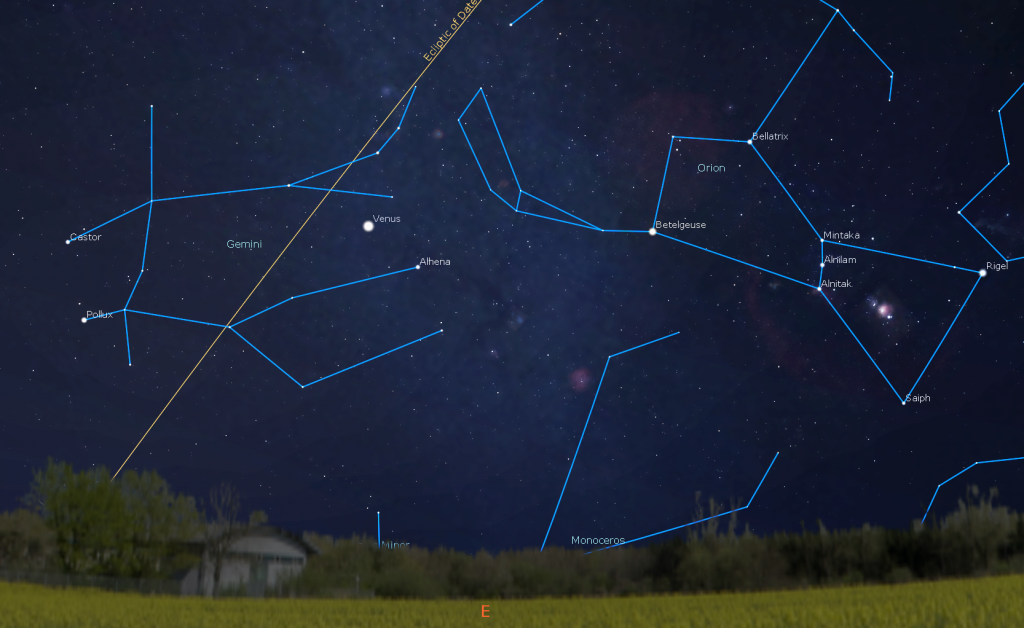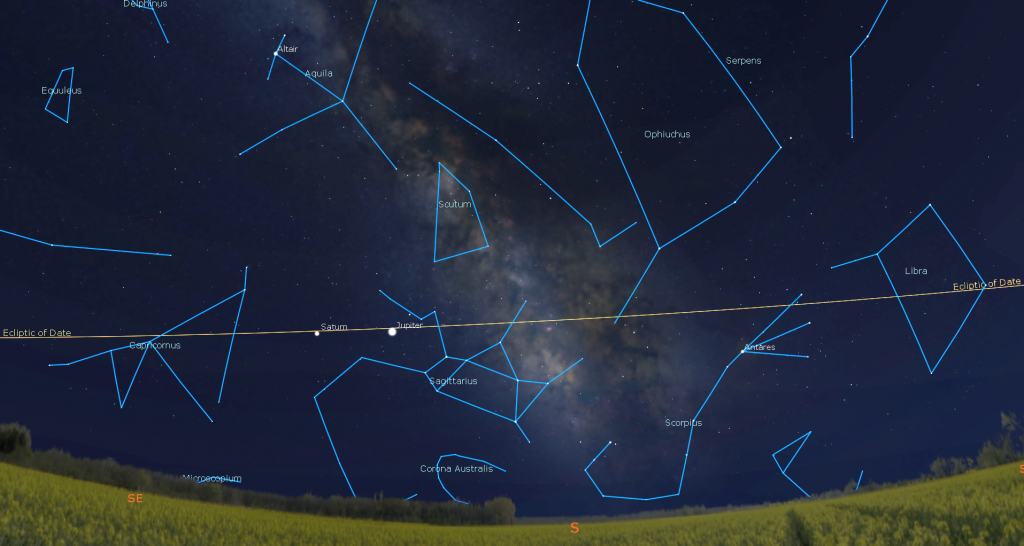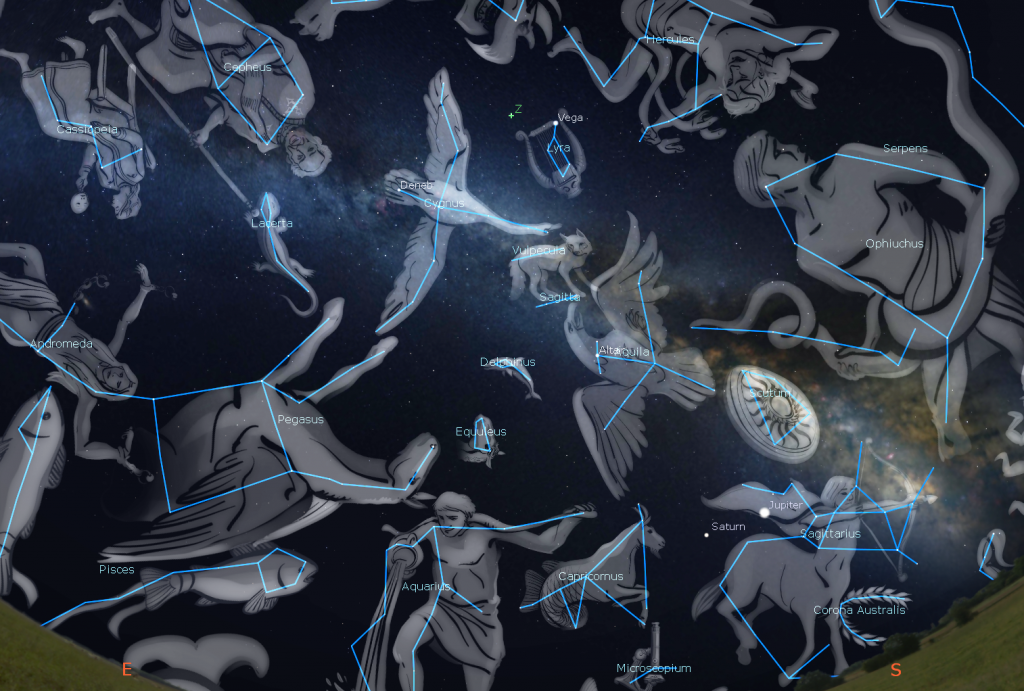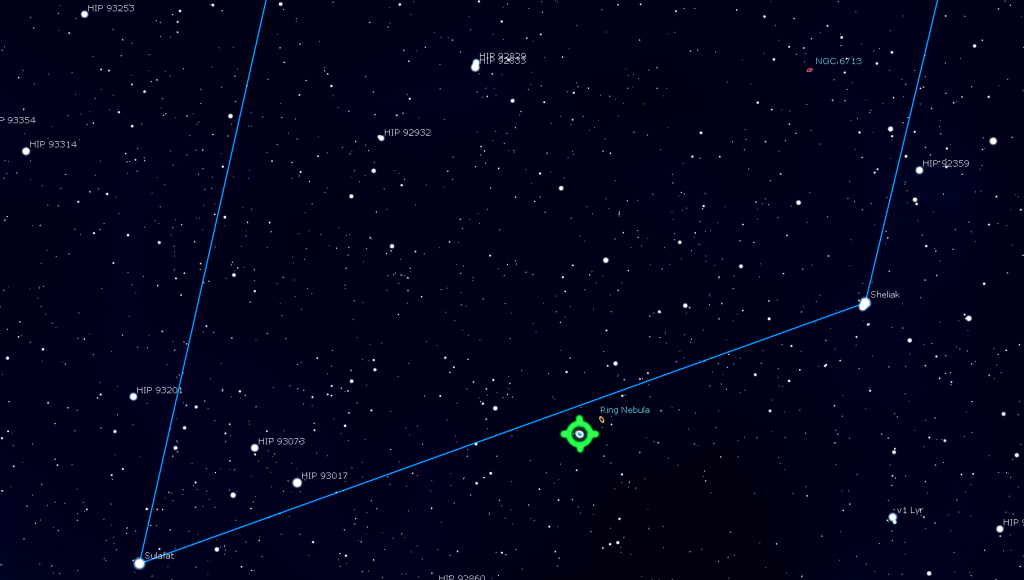Venus Blazes Before Dawn, Mainly Moonless Evenings Showcase the Harp on High, and Mars Joins Jupiter and Saturn for Evening Planet Peering!

The Ring Nebula, also known as Messier 57, in Lyra is visible in backyard telescopes as a small, grey ring. This image was taken by Ron Brecher of Guelph, Ontario on July 25, 2012. Ron’s gallery of astro-images can be accessed at www.astrodoc.ca
Hello, August Stargazers!
Here are your Astronomy Skylights for the week of August 16th, 2020 by Chris Vaughan. Feel free to pass this along to your friends and send me your comments, questions, and suggested topics. You can also follow me on Twitter as @astrogeoguy! Unless otherwise noted, all times are expressed in Eastern Time.
I can bring my Digital Starlab portable inflatable planetarium to your school or other daytime or evening event, or teach a session online. Contact me through AstroGeo.ca, and we’ll tour the Universe, or the Earth’s interior, together!
This week, the moon will pass through its new phase, and then hug the western post-sunset horizon – leaving the evenings worldwide nice and dark for stargazing in constellations like Lyra the Harp. Venus will continue to blaze before sunrise. The bright planets Jupiter, Saturn, and Mars offer will provide nice evening sights, too. Here are your Skylights!
The Moon
This week, the moon will complete a morning visit with Venus and then return to view worldwide in the early evening sky as a beautiful crescent – leaving evening skies deliciously dark for stargazers around the world. On Monday morning before dawn, look for the old crescent moon sitting well below very bright Venus in the eastern sky. The moon will officially reach its new phase at 10:42 pm EDT on Tuesday night (or on Wednesday at 2:42 Greenwich Mean Time). While at new, the moon is travelling between Earth and the sun. Since sunlight is only reaching the far side of the moon, and the moon is in the same region of the sky as the sun, the moon becomes completely hidden from view for about a day.
You might be able to see the young moon sitting just above the western horizon after sunset on Wednesday – but its slim, 1%-illuminated crescent will be a challenge to spot.
For the balance of this week, the moon will become easier to see as its orbital motion carries it farther from the sun, and thickens its crescent. But the very shallow angle that the moon’s orbit is making with the western horizon during August means that the moon will move more sideways than up, from night to night, causing the moon to set less than 30 minutes later each night this week. (It’s normally almost an hour later.) That early-setting of the moon will also add to our available moonless stargazing time!
On Thursday, the moon will begin a passage through the large constellation of Virgo (the Maiden). Its waxing crescent will sit just a finger’s width to the upper right (or 1° to the celestial north) of Virgo’s nice double star Porrima on Friday night – and on Thursday evening, it will appear a palm’s width from Virgo’s brightest star Spica. By the way, the reason I include the celestial directions in my positional descriptions is to accommodate readers who are viewing the sky from the Southern Hemisphere. Compared to us in the north, they see the moon and planets “upside-down” and flipped left for right – but N-E-S-W in the sky works the same wherever you live.
The moon will end the week as a 30%-illuminated crescent among the stars of western Libra (the Scales). The medium-bright star located a palm’s width to the moon’s left (or 6.5° to the celestial southeast) will be Zubenelgenubi. It’s another easy to discern double star. Try using your binoculars on it!
The Planets
Early risers have been noticing extremely bright Venus, which will rise in the north-northeast at about 2:45 am local time this week, and then remain visible until sunrise as it is carried higher in the eastern sky by the rotation of the Earth. Viewed in a backyard telescope, Venus will show a half-illuminated shape. This week, Venus will be sitting among the stars that form the legs of Gemini (the Twins). Venus’ orbital motion will carry it downward (eastward) through them. Venus is now dropping towards the sun – but the later sunrises of August and autumn will let it shine in a dark, pre-dawn sky until early December!

Speedy little Mercury will reach solar conjunction, when it slides past the sun on the far side of the solar system, on Monday. It will become visible again in the western post-sunset sky next week.
The middle of the night is where you’ll find three of the planets – bright, reddish Mars and the two dim, bluish, ice giants, Uranus and Neptune. Mars will put on a great sky show this autumn – but we don’t have to wait until then for good views of it! I saw its southern polar cap quite clearly in my small telescope a few nights ago.

Mars is steadily increasing in disk size and brightness because Earth is travelling towards it this summer. This week, the Red Planet will be rising in the east at about 10:30 pm in your local time zone. Mars has been speeding along the ecliptic due to the combined motions of itself and Earth. This week, it will enter the “V” of modest stars at the bottom of the constellation of Pisces (the Fishes). Mars will be visible as a prominent, reddish dot in the lower part of the sky until dawn, when it will be positioned about five fist diameters above the southwestern horizon. Nothing near Mars is as bright, nor as red!
Blue-green Uranus will rise shortly before 11 pm local time this week. It’s visible with unaided eyes and in binoculars under a dark sky. Look for the magnitude 5.8 planet sitting in southern Aries (the Ram) – about a fist’s diameter below (or 10° to the celestial south of) the ram’s brightest stars, Hamal and Sheratan. Distant Neptune is located about three fist diameters to the right (or 34° to the celestial west) of Mars. Neptune is among the stars of eastern Aquarius (the Water-Bearer). Neptune will be rising at about 9 pm local time. Then it climbs higher until about 2:45 am local time, when you’ll get your clearest view of it, almost halfway up the southern sky. Neptune is harder to find without a computerized telescope – but you can do it by “star-hopping”. This week’s moonless sky is a good time to search for it. Look for the medium-brightness stars that make a vertical line that spans a few finger widths: Phi (φ) Aquarii at top, Chi (X) Aquarii in the middle, and a group of three stars all named Psi (ψ) Aquarii at the bottom. Neptune sits just two finger widths to the left (2.75° east) of the top star.

As the evening sky darkens after sunset, very bright, white Jupiter will pop into view, low in the southeastern sky – with dimmer, yellowish Saturn positioned almost a fist’s diameter to its left (east). Good binoculars will reveal Jupiter’s four large Galilean moons named Io, Europa, Ganymede, and Callisto as they dance around the planet from night to night. Even a modest-sized telescope will show Jupiter’s brown equatorial belts and the famous Great Red Spot (or GRS, for short) if the air is steady. Due to Jupiter’s 10-hour period of rotation, the GRS appears every second or third night from a given location on Earth. In the Eastern Time zone, the Great Red Spot will be crossing the planet’s disk after dusk on Monday, Wednesday, and Saturday. It will also appear starting in late evening tonight (Sunday), Friday, and Saturday, and during the wee hours on Monday, Wednesday, and Saturday morning.

From time to time, the round, black shadows cast onto Jupiter by its Galilean moons are visible in amateur telescopes as they cross (or transit) the planet’s disk for a few hours. Commencing at 10:20 pm EDT on Monday evening, August 17, observers in the eastern Americas can watch Europa’s shadow travel across Jupiter’s northern hemisphere until 1:10 am EDT. The GRS will be visible, too, until about 11:15 pm EDT.
During the wee hours of Saturday, August 22, observers in the western half of North America can witness a rare double shadow transit. At 1:32 am CDT (or 06:32 GMT) Ganymede’s large shadow will join Io’s already-transiting smaller shadow. The pair will cross Jupiter together for nearly two hours, until Io’s shadow moves off Jupiter at 3:15 am CDT (or 08:15 GMT).

Saturn is a spectacular sight in backyard telescopes. With your unaided eyes, you should be able to spot it sitting to Jupiter’s left, starting at about 9 pm local time. Saturn’s rings, which will be narrowing every year until they vanish during the spring of 2025, will span 43 arc-seconds. (That’s about the same as Jupiter’s disk). See if you can see the Cassini Division. It’s the narrow, dark gap that separates Saturn’s inner ring from its outer one.
Even a small telescope will show several of Saturn’s moons – especially its largest, brightest moon, Titan! Because Saturn’s axis of rotation is tipped about 27° from vertical (a bit more than Earth’s axis), we can see the top surface of its rings – and its moons can arrange themselves above, below, or to either side of the planet. During this week in late evening, Titan will migrate counter-clockwise around Saturn, moving from above Saturn tonight (Sunday) to below the planet next Sunday. (Remember that your telescope might flip the view around.)
Lyra the Harp
If you missed last week’s tour of the venerable constellation of Aquila (the Eagle) I posted it with a sky chart here.
With the moon largely out of the evening sky this week, and evening darkness arriving a bit earlier, it’s a good time to tour the night sky.
Once the sky darkens, tilt your head back and look waaay up. Or set out a blanket, gravity chair, or chaise. Point your finger directly overhead. That’s the zenith – the point of the sky directly above you. During the night, various stars and constellations will pass through that patch of sky as the Earth’s rotation carries them from east to west. While objects occupy that position, they will always appear at their best. That’s because you are looking through the thinnest blanket of intervening air. (Light from objects near the horizon has to pass through as much as ten times more turbulent air – making the objects a blurry mess!)
In early evening during August and September every year, the constellations of Lyra (the Harp), Cygnus (the Swan), Hercules, and Draco (the Dragon) occupy the zenith. I’ll post a sky chart here. In the coming moonless weeks, we’ll tour them, pointing out some objects you can look at with binoculars and small telescopes. Up first is Lyra. In Greek mythology, Lyra was the musical instrument created from a turtle shell by Hermes and later used by Orpheus in his ill-fated attempt to rescue his lost love Eurydice from the underworld. We Canadian astronomers call Lyra the “Tim Hortons Constellation” because it contains both a doughnut and a double-double coffee!

Facing south and looking just to the lower right of the zenith, you’ll easily spot the very bright star Vega, also known as Alpha Lyrae – the brightest star in the constellation. Vega is the fifth brightest star in the entire night sky – partly because it is only about 25 light years away from us, and partly because it is a very hot, luminous star. The name Vega arises from the Arabic “Al Nasr al Waqi”, or the “swooping eagle”. Traditionally, the Lyre was depicted grasped in the talons of an eagle.
Vega is moving towards our sun and will continually brighten over time, becoming the brightest star in the night sky a few hundred thousand years from now. Meanwhile, the wobble of the Earth’s axis will also cause Vega to displace Polaris as the northern Pole Star. That will happen around 14,500 AD. It was previously the pole star around 12,000 BC. This star is a star!
Vega is also the brightest, highest, and most westerly of the three beautiful, blue-white stars of the Summer Triangle asterism. Moving clockwise, Altair is about three fist widths below and to the left (or 34° to the celestial south) of Vega. The star Deneb, slightly dimmer than the other two, completes the large triangle at the upper left. The separation between Deneb and Vega is shorter, only 24°, or 2.5 fist widths.
Chinese culture celebrates a love story in which a Cowherd named Niú Láng (牛郎) is the star Altair. Long ago the Cowherd and his two children, (β and γ Aquilae, the stars that flank Altair) were separated from their mother Zhī Nǚ (織女) the “Weaving Girl” (Vega) – banishing her to the far side of the river, which is represented by the Milky Way. As the story goes, each year, on the seventh day of the seventh month of the Chinese lunisolar calendar, magpies make a bridge across the Milky Way – so that the family can be together again for a single night. Some astronomers believe that the magpies are actually Perseid meteors, which travel parallel to the Milky Way every August.
Look for a medium-dim star about a finger’s width to the left of Vega. A similarly dim star sits about a finger’s width below Vega. Those three stars form a neat little triangle with Vega on the right. Binoculars or a small telescope will reveal that the triangle’s star to the left of Vega, designated Epsilon (ε) Lyrae, is actually a close pair of stars. A really good telescope will reveal that each of the pair of stars is itself a very close together pair! This quadruple star system, or “double-double”, is about 162 light-years from Earth. Even more interesting, each little pair is circling one another, and the two pairs may also be bound gravitationally – in a neat little square dance that takes thousands of years to complete! And that’s your Tim Hortons coffee!

The other corner of our little triangle is the star Zeta (ζ) Lyrae, and it, too can be split into a double star with binoculars. Both are white, and one is slightly brighter than its partner. These stars are about 152 light-years away from us, and they themselves have partners that are too close together to split visually.
Zeta is also the top right star of a narrow, upright parallelogram about two fingers wide and four fingers tall that forms the rest of the constellation – the body of the harp itself. Moving clockwise, we find Sheliak, Sulafat, and Delta (δ) Lyrae. Sheliak, meaning “Harp”, is the brightest of a tight little grouping of stars visible in a telescope. Sheliak has a close-in, dim partner that orbits the main star so that, every 13 days, the brighter star is blocked and the total brightness drops by a noticeable amount. This is called an eclipsing binary system.
Next, at the bottom of the parallelogram, sits Sulafat, meaning “Turtle”, and named for the shell forming the body of the Lyre. Sulafat is a hot, blue giant star located 620 light-years away. Similar in colour to Vega, Sulafat is much larger – an old star on its way to becoming an orange giant many years from now.
Finally, at the upper left of the parallelogram is Delta (δ) Lyrae. Sharp eyes and binoculars will easily reveal that this is yet another pair of stars – one blue (upper) and one red (lower). The two are not related – the blue star is several hundred light-years farther away than the red one. They just happen to appear close together along the same line of sight.
Above and between Sulafat and Sheliak sits a gorgeous coloured double star with the dull name of HIP92833 or HR7140. You should be able to make it out with your unaided eyes in a dark location. Viewed in a telescope, the star splits into a fantastic yellow and blue pair. A similar, but dimmer pair named HIP92932 sits only 19 arc-minutes to the southeast. That’s about half a pinky finger width to the lower left.

So, where’s our doughnut? Train your telescope midway between Sheliak and Sulafat, and look for the little, dim, grey smoke ring known as the Ring Nebula (also known as Messier 57). This little bubble of gas in space is the remnant of a dead star of a similar mass to our Sun. These common objects are called planetary nebulae because they exhibit a little round disk, like a planet. Finally, using binoculars or a telescope, sweep to the lower left the line that joins Sheliak to Sulafat. At about twice their separation (from Sulafat) is a Globular Star Cluster called Messier 56. It will appear as a dim fuzzy patch – a Timbit!
Let me know how your exploration of Lyra goes. There are lots of double stars in the constellation.
Public Astro-Themed Events
Every Monday evening, York University’s Allan I. Carswell Observatory runs an online star party – broadcasting views from four telescopes/cameras, answering viewer questions, and taking requests! Details are here. Their in-person Wednesday night viewing has been converted to online via the observatory Youtube channel, where they offer free online viewing through their rooftop telescopes, including their new 1-metre telescope! Details are here.
My Insider’s Guide to the Galaxy webcasts with Jenna Hinds of RASC National will continue on Tuesday, August 25 from 3:30 to 5 pm EDT. We’ll review how to see the planets this summer, and especially the big Mars Opposition this fall. Details and the schedule are here. Beyond that, join Jenna and John Reid on alternate Thursdays at 3:30 pm EDT as they run through the RASC’s Explore the Universe certificate.
On Wednesday evening, August 19 at 7:30 pm EDT, the RASC Toronto Centre will live stream their monthly Recreational Astronomy Night Meeting at https://www.youtube.com/rasctoronto/live. Talks include the Sky This Month, how to use your telescope to join others doing citizen science, and a history of Nicholas Copernicus. Details are here.
The Canadian organization Discover the Universe is offering astronomy broadcasts via their website here, and their YouTube channel here.
On many evenings, the University of Toronto’s Dunlap Institute is delivering live broadcasts. The streams can be watched live, or later on their YouTube channel here.
The Perimeter Institute in Waterloo, Ontario has a library of videos from their past public lectures. Their Lectures on Demand page is here.
Space Station Flyovers
There are no ISS (International Space Station) flyovers for the GTA this week.
Keep looking up, and enjoy the sky when you do. I love questions and requests. Send me some!